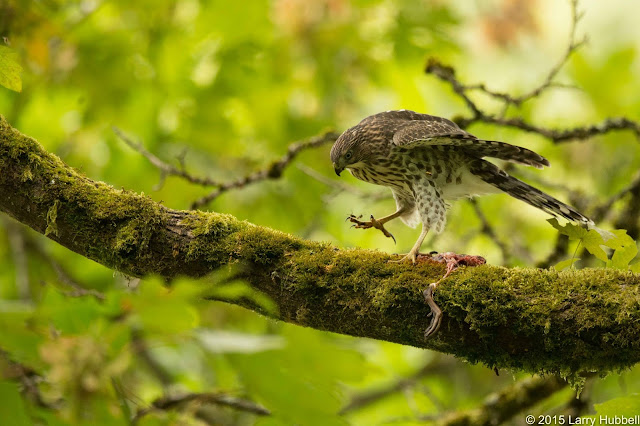Last July I was lucky enough to watch this young cooper's hawk attack its food with vigor. This was a bit of a surprise because...
...a few minutes earlier the young hawk had stopped eating. Its crop, the bulging area just below its face, was at least partially full. However, it kept one foot on the remains of its meal and called out as if to say, "This is mine, all mine." This show of possession was no doubt motivated by its two siblings who were hungrily pacing back and forth in nearby branches.
It is hard to eat when you are feeling full, so the young bird moved a few inches away and began to relax. First it stretched its tail and then its wings.
This was followed by closing its eyes and beginning to digest the meal. The remains of which are hidden in the maple leaves on the right. In spite of the temptation, neither of its siblings were brave enough to steal the remains. These three siblings are the same birds mentioned in the earlier post entitled, Fear and Trembling.
After a brief respite, the young hawk returned for more. Spreading the wings and tail to hide its food is called mantling. This must be partially instinct, as the bird clearly knew that its siblings were aware of the food.
In this case, the mantling lets us see the length of the bird's tail feathers. Their long tails enable cooper's hawks and their doppelgängers, sharp-shinned hawks, to twist and turn with precision and speed as they pursue prey through forests thick with branches, leaves and trunks.
It also shows us the white tips of the tail feathers. Ed Deal pointed out that over time this white wears aware. In mid-summer the crisp white color indicates a young bird, hatched in the last few months.
After a moment, the bird becomes focused on food and forgets all about mantling.
The scent of the fresh meat, just like salmon on the barbecue, attracts wasps. The wasp about one inch in front of the hawk's nose seems particularly brave.
This summer I watched wasps near cooper's hawks at least three different times. In fact, one cooper's hawk nest near the top of a fir tree may have been partially protected by an active wasp nest two-thirds of the way up the same tree. Maybe it is a symbiotic relationship. My theory is that the wasps feed on the hawk's left over scraps and in turn they discourage predators who might attempt to rob the nest. I would be curious to hear if anyone else has also observed this relationship.
Maybe the wasps inspired the hawk's siblings, or maybe their hunger made them bold, in any case they finally decided to try and find a place at the table. Here it is easy to see the white spots on their backs, which as Penny Lewis pointed out, are also indicators of their youth.
I do not think this extension of the wings is an attempt to hide the food. I suspect it is an intimidation tactic being used to try and keep the siblings at bay.
The mantling and calling out did resume. The siblings stayed in the same tree, but at least moved off the immediate branch.
At this point, the uneaten portion of the meal had been reduced to scraps.
The satiated young hawk steps off the food, while the wasps attend to remnants on its claws. Evidently, feeling too heavy to fly, the bird waddled away to the far end of the branch.
One of its siblings immediately darted in, grabbed the remains and pulled it towards the trunk of the tree. Shortly, there was nothing left, except the stain in the moss. In nature, there is no waste.
******************
A Note For Harmony:
Cooper's hawks eat a variety of small creatures including birds, squirrels and rats. Rodenticide can bio-accumulate in predators and lead to their demise. Old-fashioned rat traps and a spoonful of peanut butter are perfectly effective, and save the hawks. The hawks can then catch more rats! Go Hawks!
******************
Have a great day on Union Bay...where nature lives in the city!
Larry
Silhouette Challenge:
Can you determine what type of bird this is? The answer will be in next week's post.
This photo, from last week, shows a downy woodpecker. The keys that help with identification are:
a) The bird is using its tail for support against the vertical trunk of the tree, so it is most likely a woodpecker.
b) The beak being shorter than the width of the head means, that in our area, it is most likely a downy woodpecker.



















I am thinking Magpie.
ReplyDeleteEd Lamb in Bellevue
Thank you. To be fair I should have mentioned that I am only using birds that I have seen and photographed around Union Bay. So far I have only seen magpies east of the Cascades. Also I think the bird in the photo has a bit longer bill, relative to its body-size, than a magpie. Thank you for comment. It is fun to try and put my logic into words.
Deletebelted kingfisher
ReplyDeleteCorrect! I think the critical clues are the length of the bill relative to the body and the angle of the head. When kingfishers are hovering over the water, like this bird was, and preparing to dive for fish their downward focus is fairly unique, especially since an osprey's beak looks very different.
DeleteI forgot to mention the tiny little feet are also a significant kingfisher clue!
Delete